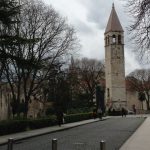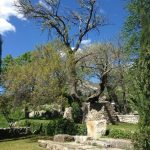The closest town to Split airport is historic Trogir, one of the treasures on the Dalmatian coast. With regular buses, it is very accessible as a day trip from Trogir, and many cruise visitors combine a tour of both Trogir and Split in the same day, such as the one offered by Split Vision Sightseeing Tours. A look at some of the heritage highlights of Trogir, courtesty of the Central Dalmatia Tourist Board.
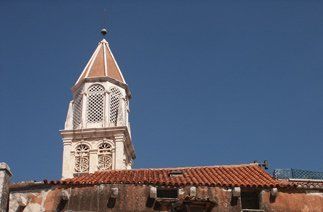 The art collection Kairos
The art collection Kairos
The Church of St. Nicholas (the art collection Kairos) with the stylistic characteristics of the Romanic and baroque periods, originated on the foundations of older churches and south gates of ancient Tragurium. It forms part of the only preserved female Benedictine monastery.
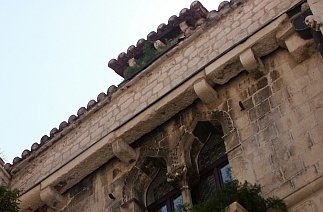 The Benedictine monastery of St. Nicholas
The Benedictine monastery of St. Nicholas
Near to the south walls of Trogir, the Benedictine Monastery is located within the Church of St. Nicholas (once St. Duje). It was founded, according to the preserved charter regarding its establishment, in 1064 by the efforts of St. Ivan of Trogir. Since the monastery was founded, life within it has never diminished. It has been populated by nuns for almost a thousand years that over history have played an important role in their town and in the wider area – particularly in the field of spirituality and in the field of Christian culture and diligence. The numerous preserved works of art and books, especially the famous collection of “Vartal” Croatian literary texts written by Petar Lučić from the 16th century, are an important part of its cultural- historical heritage.
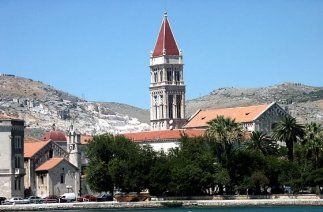 The Cathedral of St. Lawrence
The Cathedral of St. Lawrence
The Cathedral of St. Lawrence was built in the 13th century with an arched layout of the Romanesque basilica with three naves, an antechamber with three semicircular apses and is one of the most beautiful monuments in Europe. The main entrance to the Cathedral leads through the Radovan doorway, an artistic masterpiece, built in 1340. In the ante chamber is a Baptistery created by Andrija Aleši Dračanin (a Renaissance sculptor and master architect) (1467). The church tower is 47m high, built in the 14th century and is one of the most beautiful not only in Dalmatia, but also on the Mediterranean coast. Trogir’s cathedral was constructed over four centuries (1200. – 1598.) It was renovated in 2002 under the American foundation project – Venetian Heritage.
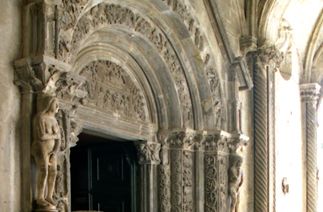 The Church and monastery of St. Dominic
The Church and monastery of St. Dominic
Among the important monuments in Trogir is the monastery of St. Dominic and its Church. We owe the oldest preserved description of the Church’s interior, to Cardinal Agostino Valier who came to visit Dalmatia in 1579 in the name of Pope Gregory XIII. From his bulletin, we discover that in that period the Church had six altars. The main altar was dedicated to St. Dominic and St. Mary Magdalene. The others were: Our Lady of Sorrows, St. Prophet, St. Vinko Ferrerski, St. Catherine of Alexandria and Our Lady of the Rosary.
The arts and beauty were from an aesthetic and theological category. This is the reason why paintings were commissioned from famous artists.
The monastery was hardly ruined in 1944 during bombardment, but was later renovated in its previous form. The roof on the eastern part and a few rooms were recently renovated.
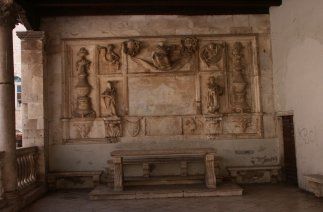 The Croatian anthem plate
The Croatian anthem plate
The Lijepa Naša plate is located on the main façade of the Town Hall (Knežev dvor), in Pope John Paul II Square of, and was placed in 1935. That year the whole of Croatia was celebrating the 100th anniversary of the origination of the Croatian anthem. It was celebrated all over Croatia in different ways, with lectures, the disclosure of spatial symbols, placing of name plates…
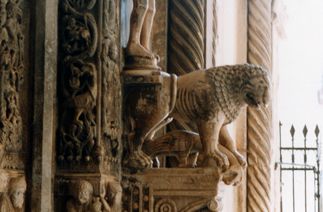 The History of Trogir
The History of Trogir
In 1242, the Tatars asked the citizens of Trogir to extradite Bela IV who was hiding here when escaping, yelling in the Croatian language so that they could be understood. Trogir minted its own money (bagattino), out of pure copper with a figure of St. Lawrence on it.
In the 19th and at the beginning of the 20th century, Trogir recorded the visits and affirmative writings of famous writers and Nobel Prize winners such as Bernard Shaw, Herman Bahr and Anatole France, giving it international appreciation as a tourist destination of interest. Following a visit by Francis I (1818) and Frederick Augustus of Poland (1838.), in 1859 Maximilian I, later Emperor to Mexico was delighted and predicted the town’s successful tourist future. The visit by Franz Joseph in 1874 marked the beginning of serious activities and the revitalisation of tourist resources.
Trogir can pride itself with the first public pharmacy on Croatian territory as of 1271, which is also believed to be the first pharmacy in Europe. It was located within the houses next to the cathedral and the town loggia. The original document supporting this fact is in a private collection, and a copy is held in the Trogir museum.
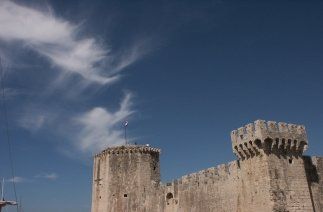 The Kamerlengo fortress
The Kamerlengo fortress
The Kamerlengo fortress is the work of artist Marin Radoje (14th -15th century). On the other side of it is the circular fortress of St. Mark dating back to the 15th century (today the Dalmatian music house). Between these two fortresses, a monument was built in the 19th century as a token of gratitude toward France.

